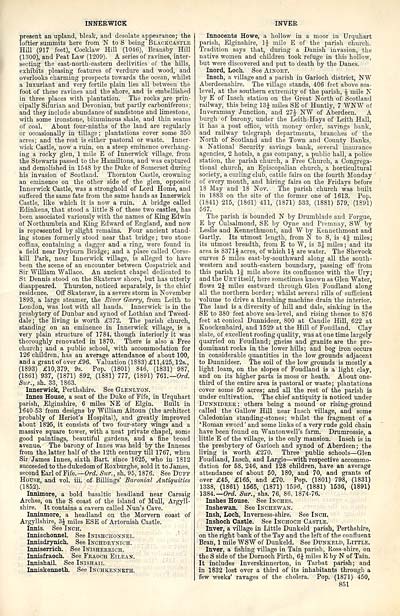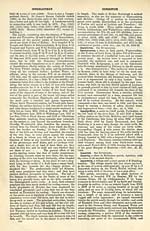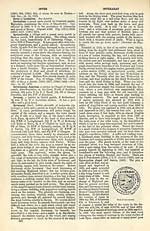Ordnance gazetteer of Scotland
(859) Page 851 - INN
Download files
Complete book:
Individual page:
Thumbnail gallery: Grid view | List view

INNERWICK
present an upland, bleak, and desolate appearance; the
loftier summits here from N to S being Blackcastle
Hill (917 feet), Cocklaw Hill (1046), Bransby Hill
(1300), and Peat Law (1209). A series of ravines, inter-
secting the east-north-eastern declivities of the hills,
exhibits pleasing features of verdure and wood, and
overlooks charming prospects towards the ocean, whilst
a luxuriant and very fertile plain lies all between the
foot of these ravines and the shore, and is embellished
in three places with plantation. The rocks are prin-
cipally Silurian and Devonian, but partly carboniferous;
and they include abundance of sandstone and limestone,
with some ironstone, bituminous shale, and thin seams
of coal. About four-ninths of the land are regularly
or occasionally in tillage ; plantations cover some 350
acres; and the rest is either pastoral or waste. Inner-
wick Castle, now a ruin, on a steep eminence overhang-
ing a rocky glen, 1 mile E of Innerwick village, from
the Stewarts passed to the Hamiltons, and was captured
and demolished in 1548 by the Duke of Somerset during
his invasion of Scotland. Thornton Castle, crowning
an eminence on the other side of the glen, opposite
Innerwick Castle, was a stronghold of Lord Home, and
suffered the same fate from the same hands as Innerwick
Castle, like which it is now a ruin. A bridge called
Edinkens, that stood a little S of these two castles, has
been associated variously with the names of King Edwin
of Northumbria and King Edward of England, and now
is represented by slight remains. Four ancient stand-
ing stones formerly stood near that bridge ; two stone
coffins, containing a dagger and a ring, were found in
a field near Dry burn Bridge; and a place called Corse-
kill Park, near Innerwick village, is alleged to have
been the scene of an encounter between Cospatrick and
Sir William Wallace. An ancient chapel dedicated to
St Dennis stood on the Skateraw shore, but has utterly
disappeared. Thurston, noticed separately, is the chief
residence. Off Skateraw, in a severe storm in November
1893, a large steamer, the Paver Garry, from Leith to
London, was lost with all hands. Innerwick is in the
presbytery of Dunbar and synod of Lothian and Tweed-
dale; the living is worth £372. The parish church,
standing on an eminence in Innerwick village, is a
very plain structure of 1784, though interiorly it was
thoroughly renovated in 1870. There is also a Free
church; and a public school, with accommodation for
126 children, has an average attendance of about 100,
and a grant of over £96. Valuation (1883) £11,425, 12s.,
(1893) £10,379, 9s. Pop. (1801) 846, (1831) 987,
(1861) 937, (1871) 892, (1881) 777, (1891) 761.— Ord.
Sur., sh. 33, 1863.
Innerwick, Perthshire. See Glenlyon.
Innes House, a seat of the Duke of Fife, in Urquhart
parish, Elginshire, 6 miles NE of Elgin. Built in
1640-53 from designs by William Aitoun (the architect
probably of Heriot's Hospital), and greatly improved
about 1825, it consists of two four-story wings and a
massive square tower, with a neat private chapel, some
good paintings, beautiful gardens, and a fine broad
avenue. The barony of Innes was held by the Inneses
from the latter half of the 12th century till 1767, when
Sir James Innes, sixth Bart, since 1625, who in 1812
succeeded to the dukedom of Roxburghe, sold it to James,
second Earl of Fife.— Ord. Sur. , sh. 95, 1876. See Duff
House, and vol. iii. of Billings' Baronial Antiquities
(1852).
Innimore, a bold basaltic headland near Carsaig
Arches, on the S coast of the island of Mull, Argyll-
shire. It contains a cavern called Nun's Cave.
Inninmore, a headland on the Morvern coast of
Argyllshire, 3| miles ESE of Artornish Castle.
Innis. See Inch.
Innischonnel. See Inishchonnel.
Innisdrynich. See Inchdrynich.
Inniserrich. See Inisherrich.
Innisfraoch. See Fraoch Eilean.
Innishail. See Inishail.
Inniskenneth. See Inchkenneth.
INVER
Innocents Howe, a hollow in a moor in Urquhart
parish, Elginshire, 1J mile E of the parish church.
Tradition says that, during a Danish invasion, the
native women and children took refuge in this hollow,
but were discovered and put to death by the Danes.
Inord, Loch. See Ainort.
Insch, a village and a parish in Garioch district, NW
Aberdeenshire. The village stands, 406 feet above sea-
level, at the southern extremity of the parish, £ mile N
by E of Insch station on the Great North of Scotland
railway, this being 13J miles SE of Huntly, 7 WNW of
Inveramsay Junction, and 27£ NW of Aberdeen. A
burgh of barony, under the Leith-Hays of Leith Hall,
it has a post office, with money order, savings bank,
and railway telegraph departments, branches of the
North of Scotland and the Town and County Banks,
a National Security savings bank, several insurance
agencies, 2 hotels, a gas company, a public hall, a police
station, the parish church, a Free Church, a Congrega-
tional church, an Episcopalian church, a horticultural
society, a curling club, cattle fail's on the fourth Monday
of every month, and hiring fairs on the Fridays before
18 May and 18 Nov. The parish church was built
in 1883 on the site of the former one of 1613. Pop.
(1841) 215, (1861) 411, (1871) 533, (1881) 579, (1891)
567.
The parish is bounded N by Drumblade and Forgue,
E by Culsalmond, SE by Oyne and Premnay, SW by
Leslie and Kennethmont, and W by Kennethmont and
Gartly. Its utmost length, from N to S, is 4g miles;
its utmost breadth, from E to W, is 3J miles ; and its
area is 8371J acres, of which 1^ are water. The Shevock
curves 5 miles east-by-southward along all the south-
western and south-eastern boundary, passing off from
this parish If mile above its confluence with the Ury;
and the Urt itself, here sometimes known as Glen Water,
flows 1\ miles eastward through Glen Foudland along
all the northern border; whilst several rills of sufficient
volume to drive a threshing machine drain the interior.
The land is a diversity of hill and dale, sinking in the
SE to 380 feet above sea-level, and rising thence to 876
feet at conical Dunnideer, 800 at Candle Hill, 622 at
Knockenbaird, and 1529 at the Hill of Foudland. Clay
slate, of excellent roofing quality, was at one time largely
quarried on Foudland; gneiss and granite are the pre-
dominant rocks in the lower hills; and bog iron occurs
in considerable quantities in the low grounds adjacent
to Dunnideer. The soil of the low grounds is mostly a
light loam, on the slopes of Foudland is a light clay,
and on its higher parts is moss or heath. About one-
third of the entire area is pastoral or waste; plantations
cover some 50 acres; and all the rest of the parish is
under cultivation. The chief antiquity is noticed under
Dunnideer; others being a mound or rising-ground
called the Gallow Hill near Insch village, and some
Caledonian standing-stones; whilst the fragment of a
' Roman sword ' and some links of a very rude gold chain
have been found on Wantonwell's farm. Drumrossie, a
little E of the village, is the only mansion. Insch is in
the presbytery of Garioch and synod of Aberdeen; the
living is worth £270. Three public schools — Glen
Foudland, Insch, and Largie — with respective accommo-
dation for 58, 246, and 128 children, have an average
attendance of about 50, 180, and 70, and grants of
over £45, £165, and £70. Pop. (1801) 798, (1831)
1338, (1861) 1565, (1871) 1596, (1881) 1536, (1891)
1384.— Ord. Sur., shs. 76, 86, 1874-76.
Inshes House. See Inches.
Inshewan. See Inchewan.
Insh, Loch, Inverness-shire. See Inch.
Inshoch Castle. See Inchoch Castle.
Inver, a village in Little Dunkeld parish, Perthshire,
on the right bank of the Tay and the left of the confluent
Bran, 1 mile WSW of Dunkeld. See Dunkeld, Little.
Inver, a fishing village in Tain parish, Ross-shire, on
the S side of the Dornoch Firth, 6J miles E by N of Tain.
It includes Inverskinnerton, in Tarbat parish; and
in 1832 lost over a third of its inhabitants through a
few weeks' ravages of the cholera. Pop. (1871) 450,
851
present an upland, bleak, and desolate appearance; the
loftier summits here from N to S being Blackcastle
Hill (917 feet), Cocklaw Hill (1046), Bransby Hill
(1300), and Peat Law (1209). A series of ravines, inter-
secting the east-north-eastern declivities of the hills,
exhibits pleasing features of verdure and wood, and
overlooks charming prospects towards the ocean, whilst
a luxuriant and very fertile plain lies all between the
foot of these ravines and the shore, and is embellished
in three places with plantation. The rocks are prin-
cipally Silurian and Devonian, but partly carboniferous;
and they include abundance of sandstone and limestone,
with some ironstone, bituminous shale, and thin seams
of coal. About four-ninths of the land are regularly
or occasionally in tillage ; plantations cover some 350
acres; and the rest is either pastoral or waste. Inner-
wick Castle, now a ruin, on a steep eminence overhang-
ing a rocky glen, 1 mile E of Innerwick village, from
the Stewarts passed to the Hamiltons, and was captured
and demolished in 1548 by the Duke of Somerset during
his invasion of Scotland. Thornton Castle, crowning
an eminence on the other side of the glen, opposite
Innerwick Castle, was a stronghold of Lord Home, and
suffered the same fate from the same hands as Innerwick
Castle, like which it is now a ruin. A bridge called
Edinkens, that stood a little S of these two castles, has
been associated variously with the names of King Edwin
of Northumbria and King Edward of England, and now
is represented by slight remains. Four ancient stand-
ing stones formerly stood near that bridge ; two stone
coffins, containing a dagger and a ring, were found in
a field near Dry burn Bridge; and a place called Corse-
kill Park, near Innerwick village, is alleged to have
been the scene of an encounter between Cospatrick and
Sir William Wallace. An ancient chapel dedicated to
St Dennis stood on the Skateraw shore, but has utterly
disappeared. Thurston, noticed separately, is the chief
residence. Off Skateraw, in a severe storm in November
1893, a large steamer, the Paver Garry, from Leith to
London, was lost with all hands. Innerwick is in the
presbytery of Dunbar and synod of Lothian and Tweed-
dale; the living is worth £372. The parish church,
standing on an eminence in Innerwick village, is a
very plain structure of 1784, though interiorly it was
thoroughly renovated in 1870. There is also a Free
church; and a public school, with accommodation for
126 children, has an average attendance of about 100,
and a grant of over £96. Valuation (1883) £11,425, 12s.,
(1893) £10,379, 9s. Pop. (1801) 846, (1831) 987,
(1861) 937, (1871) 892, (1881) 777, (1891) 761.— Ord.
Sur., sh. 33, 1863.
Innerwick, Perthshire. See Glenlyon.
Innes House, a seat of the Duke of Fife, in Urquhart
parish, Elginshire, 6 miles NE of Elgin. Built in
1640-53 from designs by William Aitoun (the architect
probably of Heriot's Hospital), and greatly improved
about 1825, it consists of two four-story wings and a
massive square tower, with a neat private chapel, some
good paintings, beautiful gardens, and a fine broad
avenue. The barony of Innes was held by the Inneses
from the latter half of the 12th century till 1767, when
Sir James Innes, sixth Bart, since 1625, who in 1812
succeeded to the dukedom of Roxburghe, sold it to James,
second Earl of Fife.— Ord. Sur. , sh. 95, 1876. See Duff
House, and vol. iii. of Billings' Baronial Antiquities
(1852).
Innimore, a bold basaltic headland near Carsaig
Arches, on the S coast of the island of Mull, Argyll-
shire. It contains a cavern called Nun's Cave.
Inninmore, a headland on the Morvern coast of
Argyllshire, 3| miles ESE of Artornish Castle.
Innis. See Inch.
Innischonnel. See Inishchonnel.
Innisdrynich. See Inchdrynich.
Inniserrich. See Inisherrich.
Innisfraoch. See Fraoch Eilean.
Innishail. See Inishail.
Inniskenneth. See Inchkenneth.
INVER
Innocents Howe, a hollow in a moor in Urquhart
parish, Elginshire, 1J mile E of the parish church.
Tradition says that, during a Danish invasion, the
native women and children took refuge in this hollow,
but were discovered and put to death by the Danes.
Inord, Loch. See Ainort.
Insch, a village and a parish in Garioch district, NW
Aberdeenshire. The village stands, 406 feet above sea-
level, at the southern extremity of the parish, £ mile N
by E of Insch station on the Great North of Scotland
railway, this being 13J miles SE of Huntly, 7 WNW of
Inveramsay Junction, and 27£ NW of Aberdeen. A
burgh of barony, under the Leith-Hays of Leith Hall,
it has a post office, with money order, savings bank,
and railway telegraph departments, branches of the
North of Scotland and the Town and County Banks,
a National Security savings bank, several insurance
agencies, 2 hotels, a gas company, a public hall, a police
station, the parish church, a Free Church, a Congrega-
tional church, an Episcopalian church, a horticultural
society, a curling club, cattle fail's on the fourth Monday
of every month, and hiring fairs on the Fridays before
18 May and 18 Nov. The parish church was built
in 1883 on the site of the former one of 1613. Pop.
(1841) 215, (1861) 411, (1871) 533, (1881) 579, (1891)
567.
The parish is bounded N by Drumblade and Forgue,
E by Culsalmond, SE by Oyne and Premnay, SW by
Leslie and Kennethmont, and W by Kennethmont and
Gartly. Its utmost length, from N to S, is 4g miles;
its utmost breadth, from E to W, is 3J miles ; and its
area is 8371J acres, of which 1^ are water. The Shevock
curves 5 miles east-by-southward along all the south-
western and south-eastern boundary, passing off from
this parish If mile above its confluence with the Ury;
and the Urt itself, here sometimes known as Glen Water,
flows 1\ miles eastward through Glen Foudland along
all the northern border; whilst several rills of sufficient
volume to drive a threshing machine drain the interior.
The land is a diversity of hill and dale, sinking in the
SE to 380 feet above sea-level, and rising thence to 876
feet at conical Dunnideer, 800 at Candle Hill, 622 at
Knockenbaird, and 1529 at the Hill of Foudland. Clay
slate, of excellent roofing quality, was at one time largely
quarried on Foudland; gneiss and granite are the pre-
dominant rocks in the lower hills; and bog iron occurs
in considerable quantities in the low grounds adjacent
to Dunnideer. The soil of the low grounds is mostly a
light loam, on the slopes of Foudland is a light clay,
and on its higher parts is moss or heath. About one-
third of the entire area is pastoral or waste; plantations
cover some 50 acres; and all the rest of the parish is
under cultivation. The chief antiquity is noticed under
Dunnideer; others being a mound or rising-ground
called the Gallow Hill near Insch village, and some
Caledonian standing-stones; whilst the fragment of a
' Roman sword ' and some links of a very rude gold chain
have been found on Wantonwell's farm. Drumrossie, a
little E of the village, is the only mansion. Insch is in
the presbytery of Garioch and synod of Aberdeen; the
living is worth £270. Three public schools — Glen
Foudland, Insch, and Largie — with respective accommo-
dation for 58, 246, and 128 children, have an average
attendance of about 50, 180, and 70, and grants of
over £45, £165, and £70. Pop. (1801) 798, (1831)
1338, (1861) 1565, (1871) 1596, (1881) 1536, (1891)
1384.— Ord. Sur., shs. 76, 86, 1874-76.
Inshes House. See Inches.
Inshewan. See Inchewan.
Insh, Loch, Inverness-shire. See Inch.
Inshoch Castle. See Inchoch Castle.
Inver, a village in Little Dunkeld parish, Perthshire,
on the right bank of the Tay and the left of the confluent
Bran, 1 mile WSW of Dunkeld. See Dunkeld, Little.
Inver, a fishing village in Tain parish, Ross-shire, on
the S side of the Dornoch Firth, 6J miles E by N of Tain.
It includes Inverskinnerton, in Tarbat parish; and
in 1832 lost over a third of its inhabitants through a
few weeks' ravages of the cholera. Pop. (1871) 450,
851
Set display mode to: Large image | Transcription
Images and transcriptions on this page, including medium image downloads, may be used under the Creative Commons Attribution 4.0 International Licence unless otherwise stated. ![]()
| Gazetteers of Scotland, 1803-1901 > Ordnance gazetteer of Scotland > (859) Page 851 - INN |
|---|
| Permanent URL | https://digital.nls.uk/97403554 |
|---|

